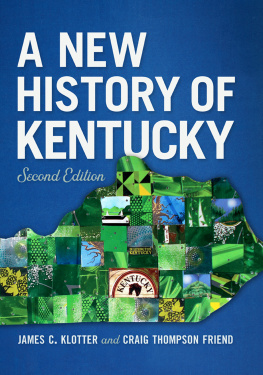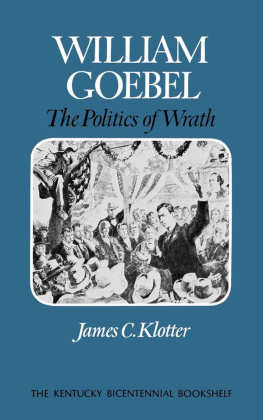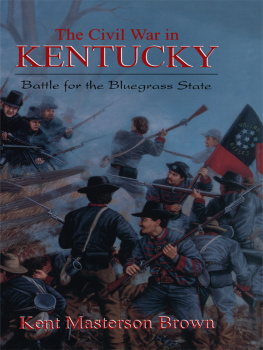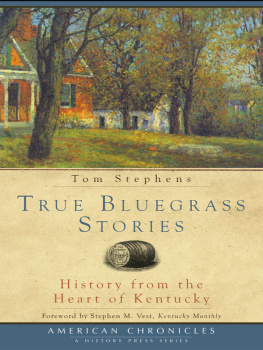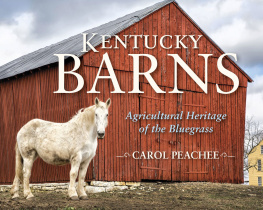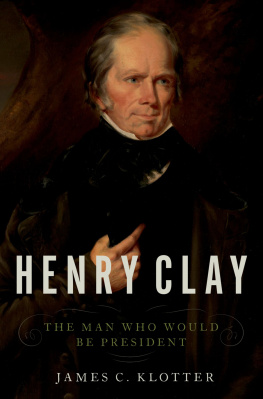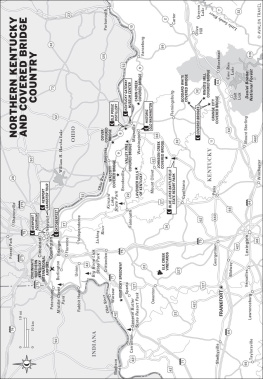Many of the essays in this volume were originally presented at a conference that was made possible in part by a Challenge Grant from the National Endowment for the Humanities.
Copyright 2012 by The University Press of Kentucky
Scholarly publisher for the Commonwealth, serving Bellarmine University, Berea College, Centre College of Kentucky, Eastern Kentucky University, The Filson Historical Society, Georgetown College, Kentucky Historical Society, Kentucky State University, Morehead State University, Murray State University, Northern Kentucky University, Transylvania University, University of Kentucky, University of Louisville, and Western Kentucky University.
All rights reserved.
Editorial and Sales Offices: The University Press of Kentucky 663 South Limestone Street, Lexington, Kentucky 40508-4008
www.kentuckypress.com
16 15 14 13 12 5 4 3 2 1
Library of Congress Cataloging-in-Publication Data
Bluegrass renaissance : the history and culture of central Kentucky, 1792-1852 / edited by James C. Klotter and Daniel Rowland.
p. cm.
Includes bibliographical references and index.
ISBN 978-0-8131-3607-3 (hardcover : acid-free paper)
ISBN 978-0-8131-3663-9 (pdf) ISBN 978-0-8131-4043-8 (epub)
1. Lexington (Ky.)History18th century. 2. Lexington (Ky.)History19th century. 3. Lexington (Ky.)Social life and customs. 4. Lexington (Ky.)Intellectual life. 5. Lexington Region (Ky.)History18th century. 6. Lexington Region (Ky.)History19th century. 7. Lexington Region (Ky.)Social life and customs. 8. Lexington Region (Ky.)Intellectual life. I. Klotter, James C. II. Rowland, Daniel B. (Daniel Bruce), 1941III. Title.
F459.L6B55 2012
976.947dc23
2012019013
This book is printed on acid-free paper meeting the requirements of the American National Standard for Permanence in Paper for Printed Library Materials.
Manufactured in the United States of America.
| Member of the Association of American University Presses |
Introduction
What causes a city to be termed great in a moment in time? Why is a town seen as a place of progress and modernization in a specific region? What features create an environment that produces leadership in a variety of fields? What forces give birth to advancements in one area after another? And what elements combine to change the history of a place from one of betterment and hope to one of pessimism and despair? Finally, what aspects of the past, real or imagined, remain in that place, as parts that continue to form a new future?
To answer these and other questions, Daniel Rowland organized the 2007 symposium at which most of these essays were first presented. As director of the Gaines Center for the Humanities at the University of Kentucky and head of the universitys Marshall-Rhodes Selection Committee, Rowland had his historical interest in those queries stimulated through his work on the project to restore the Senator John and Eliza Pope Villa, built in 1812 in Lexington, and designed by the foremost architect of the period, Benjamin Henry Latrobe. Latrobe, the father of the architectural profession in the United States, is generally recognized as the greatest American architect before the age of Louis Sullivan and Frank Lloyd Wright.
Patrick Snadon, one of our essayists, established in a magisterial book he wrote with Michael Fazio on the domestic architecture of Latrobe that the Pope Villa is probably the most important of all Latrobes domestic buildings, built or unbuilt, standing or demolished, in England or America. That would make the Pope Villa arguably the most important federal-period building in America from a strictly architectural point of
Why was this amazing villa built in Lexington in 1812? This was the question that Rowland heard again and again over two decades, from both native Kentuckians and visitors, as he gave tours of the Pope Villa. Similarly, James C. Klotter had heard even broader questions along the same lines, in his role as the state historian of Kentucky.
A response to those experiences was the symposium The Idea of the Athens of the West: Central Kentucky in American Culture, 17921852, sponsored by the Gaines Center, with Transylvania University, the University of Kentuckys College of Arts and Sciences, and the National Endowment for the Humanities. Most of the essays included in the present volume were given in preliminary form during that conference. (The dates chosen marked Kentuckys achievement of statehood and the death of Henry Clay, the close of an era.)
This collection attempts to answer the queries so often posed by visitors to the Pope Villa by examining the impressive cultural achievements (and problems) created by central Kentuckians in the first half of the nineteenth century and by addressing the questions raised earlier.
We have grouped the essays under headings to help readers understand this context. The first section is the most general. Klotter gives a concise overview of central Kentucky during the period under discussion, highlighting both the remarkable achievements of Kentuckians and the major problems (including slavery) that their society faced. Stephen Arons memorable essay suggests that historians and the public make a mistake when they imagine European migration into Kentucky, and the West more generally, as proceeding from east to west. He examines the movements of Frenchmen, Spaniards, and others to show that it was a multidimensional affair. Finally, the late Shearer Davis Bowman compares central Kentucky as the Athens of the West with the original Athens of fifth-century BCE Greece.
The middle section of the book has a more sociological focus. Gerald L. Smith examines the history of slavery in central Kentucky and the attempts of antislavery advocates to change that institution. Randolph Hollingsworth outlines images of womanhood held by Kentuckians and describes some remarkable women. Maryjean Wall describes the development of horse breeding and racing. She searches for the advantages that allowed Kentucky horsemen to dominate their industry, particularly compared to their colleagues in Tennessee. Finally, Mark V. Wetherington goes beyond the usual (but important) narratives of the national importance of Kentucky politicians, including Henry Clay, to examine the influence of Kentuckians on the politics of other areas, particularly Texas.


